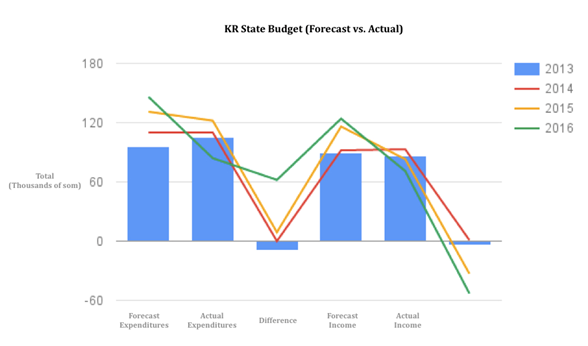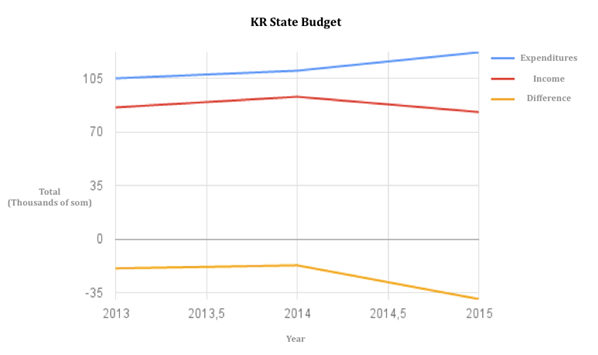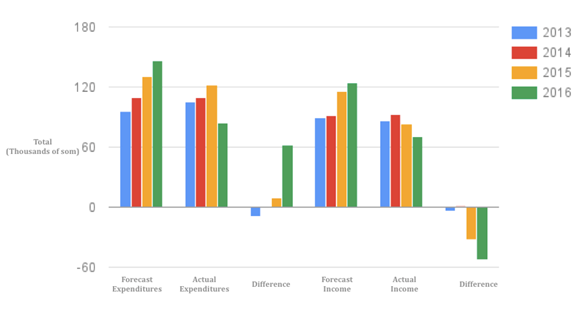“Upkeep of the state apparatus should not exceed 15% of GDP, and anything greater should automatically invoke criminal responsibility upon members of the Kyrgyz Republic’s government,” – economist Iskender Sharsheyev, writing specially for cabar.asia, shares his views on Kyrgyzstan’s administration of the state budget.
Follow us on LinkedIn!
 Every second Kyrgyzstani is a dependent
Every second Kyrgyzstani is a dependent
The Kyrgyz Republic’s state budget employs 321,000 individuals, according to the National Statistical Committee. In total, 17,800 are civil servants, and the rest are mostly military personnel and public sector workers without civil servant status. Cash flows from the State Social Fund are kept secret, but information about the additional financing of pensions and benefits directly from the state budget periodically pops up in the media. 608,000 people are of retirement-age. From 2014 to 2015, the number of pensioners increased by 31,000.
It is worth noting that the country’s total of employed, economically active individuals is 2.3 million, of which nearly one million are dependent on the state budget. That means 1.3 million are working to pay the salaries, allowances, and pensions of one million. At the same time, it should be clearly understood that one million people do not generate added value, i.e. economic worth, which can be one of the major causes of inhibition and the weak development Kyrgyzstan’s economy.
What is the state of Kyrgyzstan’s budget?
What is the state of the state budget? This question must be answered by the Budget Code, which will come into force on January 1, 2017. The Budget Code mainly draws on and emphasizes budget revenue statistics, which we suppose are correct. But to date these issues are regulated by the basic principles of the budget law. Article 9 defines the need to forecast future budget revenues. Usually this means the following process:
- A department or ministry is tasked by the Ministry of Finance to form a forward-looking estimate.
- Department or ministry experts take the expenditures of the organization over the past year, add new costs, and calculate the inflationary increase in spending.
- The head of a ministry or department then takes the forecasted budget and sends it to the Ministry of Finance where the document is analyzed by a number of departments. The deputy minister shall be responsible for the review process. Some articles do end up being cut off from funding. Draft budgets are gathered from all ministries and departments and then submitted to the Prime Minister for approval.
- The prime minister shall bring these up for discussion in the Jogorku Kenesh. Deputies are not responsible for the budget’s replenishment or expenditure but have the ability to influence its distribution. It is in their purview to increase the expenditure part of the budget by a vote. The JK discusses the draft state budget for the next year and adopts it.
- After that, the government begins to adjust the projected figures based on alterations made by parliament, the prime minister, and, in some cases, the presidential administration.
Table & Figure 1. State budget over 4 years (forecast)
In drawing up the budget, it is easy to note the trend towards a steady increase on the expenditure side of the budget without identifying its recipients. Of course, 80% of the state budget’s tax revenues are from businesses. The major share of the expenditure side of the budget is for grants, loans, and other obligations. Often, these forecasts are extremely optimistic.
The budget is a political instrument so the party in power often influences how it is spent. For example, if it turns out that the budget was too optimistic and its projected income is not possible, a deficit will form as a result of the ruling party’s amendments to the budget. In particular, this means that a sequestered budget can be introduced where reduced numbers are already projected; the budget is adjusted and artificially reduced to the expected deficit. Given that large budget deficits could cause protests among the population and score negative political points, a certain number of persons and organizations are responsible for it.
It is because of the budget deficits of previous years with responsibility falling on the country itself and its international debt obligations that the national debt has formed.
So, to date, the country’s external debt amounts to 255 billion som due to its obligations under international loans, late membership fees to international organizations, etc. Domestic debt amounts to 21 billion som and is mostly unpaid pensions, unfinished construction of social facilities, commitments to benefits, incomplete salaries and bonuses for civil servants, and other obligations. National debt is 276 billion som and stems from other contracts.
The fact is that state budget expenditures show that the state often resorts to foreign loans for help, which increase external debt over time. To put it simply, the state is robbing itself of the right to future revenues.
Table & Figure 2. State budget over 4 years (actual)
In fact, there is a difference between insufficient income and overspending, which shows an absence of a long-term state strategy for the development of a balanced and self-sufficient state economy. As a result of the budget plan, there is a high probability of partially losing sovereignty due to the presence of debt and the overwhelming influence of external creditors. This is compounded by harbored protest or apathetic sentiments, due to unfulfilled political promises, concerning the domestic debt.
Table & Figure 3. State budget over 4 years (forecast vs. actual)

 Figure 4. Comparison of fluctuations in budget performance (forecast vs. actual)
Figure 4. Comparison of fluctuations in budget performance (forecast vs. actual)
When 2017 will be introduced into the current Budget Code, there is hope that a more responsible, structured, and, most importantly, focused state budget plan will be balanced and rely on real incomes.
How is the neighbor?
Figure 5. Kazakhstan’s national budget figures, 2013-2018
In Kazakhstan, there is a tendency of growing budget expenditures but a balance is kept between expenditures and income. However, even with this, there is still a growing budget deficit. In 2016, Kazakhstan’s external debt amounted to $154 billion, which is 92% of GDP. In contrast to the Kyrgyz Republic, Kazakhstan was much more reckless in its public debt management policy. However, the size of the Kazakhstani economy and the last years of the oil boom have given the country a large degree of safety. Judging by the budgetary figures, Kazakhstan is also a welfare state, and, like Kyrgyzstan, is in an at-risk cohort of countries that are conducting policies of slow bankruptcy.
What will happen in 2017?
The total volume of state budget revenues, taking into account the climate of foreign investment grants for 2017, is forecasted to be 140.9 billion som or 28.5% of GDP, which is a decrease of 500.6 million som when compared to the 2016 state budget. The total amount of state expenditures for 2017 will be 164.25 billion som or 33.2% of GDP, which is 367.5 million som more than the approved budget for 2016. What are the reasons for this? Objective reasons other than inflation, devaluation, and the release of som into mass circulation seem difficult to find.
The Austrian dream budget
How could the budget appear as a conservative economist’s dream? A supporter of the Austrian School of Economics would say that the real power of the country and the people is in a compact state that is able to manage their finances like an international company focused on profit and increasing citizens’ incomes.
- Assets must always exceed liabilities. Or to put it simply, the net government revenues from taxes and fees must always exceed the total expenditures of the state.
- Upkeep of the state apparatus should not exceed 15% of GDP, and anything greater should automatically invoke criminal responsibility upon members of the Kyrgyz Republic’s government.
- The country’s national projects must be financed exclusively by attracting institutional investors, domestic private investors, or surplus government revenue.
- The State shall endeavor to pay off international loans, and continue to avoid the use of debt instruments in the organization of public finance.
- The state should necessarily finance the costs of security issues, international trade, and foreign policy while the private sector will bear the remaining issues on their shoulders, i.e. outsourcing.
- Require statements to clearly separate state finances from attracted investment. All attracted investment should go through the private sector only and without government financial guarantees.
Here is the ideal administration of the state budget though it is nowhere close given the realities of today.
References:
Budget Codex of the Kyrgyz Republic, 2016, http://online.adviser.kg/Document/?doc_id=36650298&page=1.
Djunusova, R. M., A. K. Djunusova, and G. B. Utibaeva. “СРАВНИТЕЛЬНЫЙ АНАЛИЗ ПРОГНОЗНЫХ ПОКАЗАТЕЛЕЙ РЕСПУБЛИКАНСКОГО БЮДЖЕТА НА 2014-2016 ГОДЫ” [Comparative Analysis of the Forecast Indicators of the National Budget for 2014-2016]. Vestnik 81, no. 2 (2014): 115–23. Accessed November 14, 2016. http://kazatu.kz/science/vn1402_ekonom02.pdf.
For.kg. В Кыргызстане количество служащих составляет 321 тыс. человек [In Kyrgyzstan, there are 321,000 civil servants]. January 22, 2011. http://www.for.kg/news-144343-ru.html.
Government decision on the law concerning the state budget of the Kyrgyz Republic for 2014 and the forecast for 2015-2016, 2013, http://cbd.minjust.gov.kg/act/view/ru-ru/96021?cl=ru- ru.
Kyrtag.kg. В Кыргызстане за 10 лет число пенсионеров выросло в полтора раза [For the past 10 years in Kyrgyzstan, the number of pensioners has increased by half]. January 19, 2015. http://kyrtag.kg/news/v-kyrgyzstane- za-10-let-chislo-pensionerov-vyroslo-v-poltora-raza/.
Law concerning the implementation of the Budget Code of the Kyrgyz Republic, 2016, http://online.adviser.kg/Document/?link_id=1005179231.
Law concerning the state budget of the Kyrgyz Republic for 2014 and the forecast for 2015-2016, 2013, http://cbd.minjust.gov.kg/act/view/ru-ru/203817?cl=ru- ru.
Law on the basic principles of the budget law of the Kyrgyz Republic, 1999, http://municipalkg.narod.ru/finlaw/mlaw/Z98-78.htm.
Law concerning the state budget of the Kyrgyz Republic for 2015 and the forecast for 2016-2017, 2014, http://cbd.minjust.gov.kg/act/view/ru-ru/205397?cl=ru- ru.
Law concerning the state budget of the Kyrgyz Republic for 2016 and the forecast for 2017-2018, 2015, http://cbd.minjust.gov.kg/act/view/ru-ru/111277?cl=ru-ru.
Ministry of Finance of the Kyrgyz Republic. Структура Министерства финансов Кыргызской Республики [Structure of the Ministry of Finance of the Kyrgyz Republic]. Bishkek, 2015. http://www.minfin.kg/ru/novosti/rukovodstvo/bashkarmalyktar-zhana-z- aldyncha-blmdr/upravleniya-i-samostoyatelnye-otdely-.html.
“Portal ‘Open Budget.’” Accessed November 14, 2016. http://budget.okmot.kg/en/.
“Республиканский бюджет” [Republican Budget]. Accessed November 14, 2016. http://budget.kz/respublikanckiy-byudzhet/
Author: Iskender Sharsheyev, executive director of the Association of Foreign Investors (Kyrgyzstan, Bishkek).
The opinions expressed in this article are the author’s own and do not necessarily reflect the view of cabar.asia.








